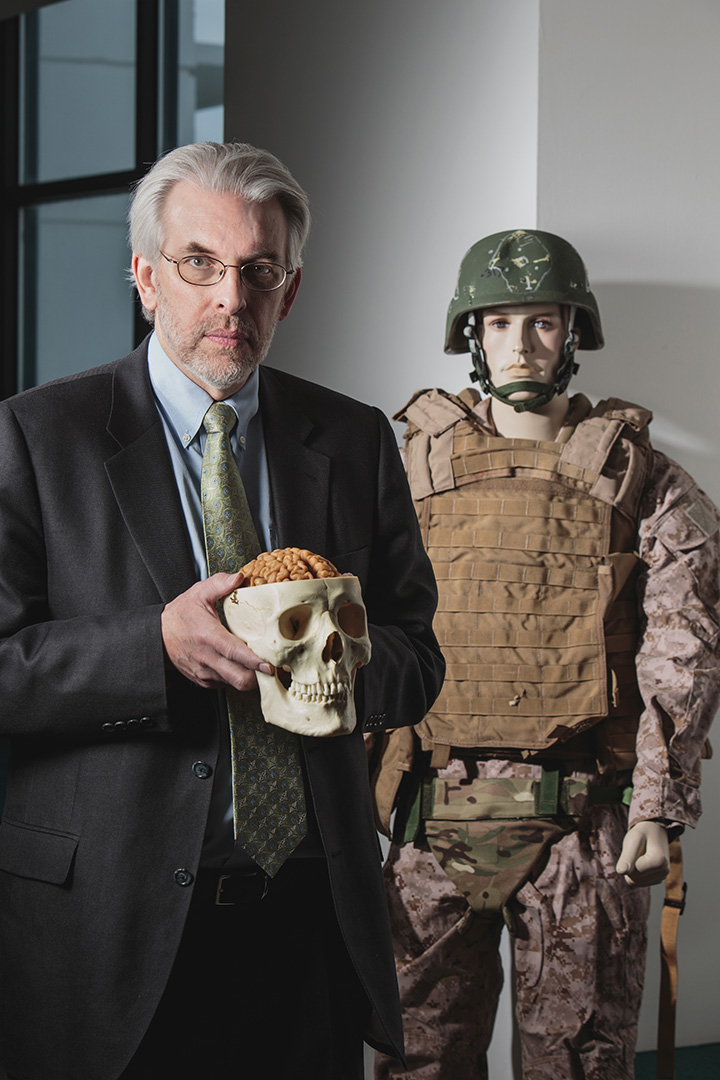Tactical Engineering - Today
One of the most common injuries that soldiers in Iraq and Afghanistan sustain is traumatic brain injury due to blast impacts.
Blast injuries are not well understood from a medical perspective, and body armor performance is not well understood from an engineering perspective. Peter Matic (ME ’77) of the United States Naval Research Laboratory is working to relate blast pressure impacts to the motion of the brain and changes in neuronal cells.

Photo: Mike Olliver
“We want to bridge the gap between the engineering and medical fields by gaining a better understanding of injury processes and the way personal protective equipment performs,” says Matic, superintendent of the Materials Science and Technology Division at NRL.
In standard crash test dummies, a metallic model of the human head with a rubber coating and sensors mounted to the interior is used to measure accelerations from blunt impact. In contrast, Matic and his team wanted to focus on soft tissue and skeletal structures for the blast pressure. Matic proposed to simulate the likeness of a brain using soft polymers and an array of embedded sensors. They called him GelMan.
To build GelMan, Matic’s colleague Amit Bagchi, who also has a background in mechanical engineering, worked on the design, fabrication, and testing strategies. Chris Kindle, also a mechanical engineer, used a mold from an anatomical model of the brain, and then filled that mold with a polymer. While casting the brain, sensors were embedded that measure pressure and acceleration. The brain was then placed inside the polymer skull, mounted on a neck component, and applied with soft coatings on top to simulate skin.
Thomas O’Shaughnessy, a neuroscientist, brought expertise in cellular-level work to measure what percentage of cells survive in the hours and days after a blast. The team quantified how a cell would respond to blast pressures and discovered that cells die off at a faster rate if exposed to certain levels of blast.
Matic’s research team specifically measures how the brain responds to primary blast pressure. They are also interested in the effect of blast fragments, so they analyze high-speed video of fragments, track shockwaves hitting the target, and measure the relative motion of the protective equipment and the body.
“This type of research, data, and technology provides a more complete description of blast, ballistic, and blunt impact,” Matic says. “We want to optimize equipment and continually improve performance.”
Research coming out of NRL provides information that helps the U.S. Marine Corps make decisions based upon quantitative data that describes how different equipment performs.
“The entrepreneurial environment at NRL allows us to do basic research that transitions into the applied realm and provides the Navy, Marine Corps, and Department of Defense with superior technologies,” Matic says. “It’s a good place for collaboration between the disciplines needed to solve challenging problems.”
More Online
U.S. Department of Defense Special Report on Traumatic Brain Injury: www.defense.gov/home/features/2012/0312_tbi
United States Naval Research Laboratory: www.nrl.navy.mil